Forklift Truck Batteries: Currently, within the industry can find different types of batteries for forklifts, which are differentiated by their uses and applications.
Its main function is based on storing enough energy to start the forklift engine. Its secondary function is to store the remaining energy for later use in equipment for extended periods.
In the same sense, forklifts that are used with different uses also require care, especially with regard to the maintenance of forklift batteries.
Do you know the different types of batteries for forklifts truck?
What are the main characteristics of forklift truck batteries?
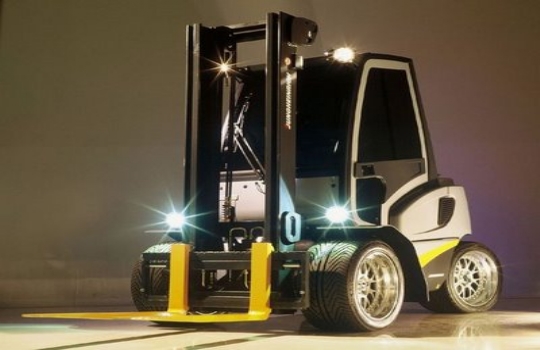
Lift truck battery
The most common forklift battery is one that contains lead-acid and includes a lead plate (negative electrode), an electrolyte solution of sulfuric acid and another lead peroxide plate (positive electrode). Every time you operate a forklift or other motorized vehicle, inspect it to verify that it is working properly.
It is worth mentioning that the best way to preserve the batteries, whatever they may be, is through a daily control of their condition and a good use of them, but to do this, make a good maintenance of forklift batteries, you need to incorporate a vital information series otherwise you can not do it efficiently.
- First of all, keep in mind that a battery and a battery are electrochemical devices that have the capacity to store energy in a completely chemical way.
- Once the battery is fully or partially charged, this chemical energy is transformed into electrical energy that is subsequently transmitted via a circuit to a motor that transforms it once again, this time into mechanical energy that enables the movement of the vehicle.
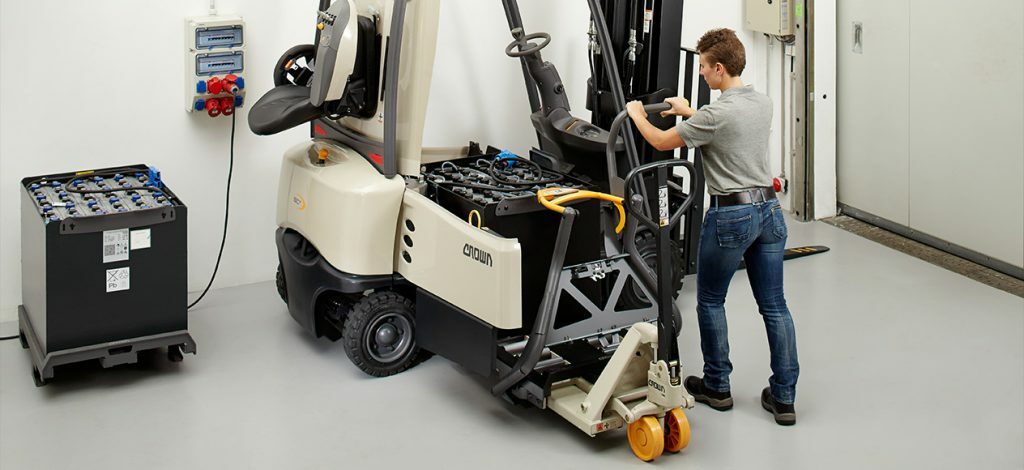
Forklift battery types
The vast majority of modern batteries are manufactured following a similar pattern, in this case, a series of internal cells that mark the voltage that the battery will have, plus cells plus voltage. The batteries provide power and counterbalance to the forklifts. Batteries can weigh up to 1,000k.
Voltage: It is worth adding that the voltage of each of the cells is two volts. But in spite of this common characteristic, in the modern market, several types of batteries can be found.
Rechargeable batteries: The second variant within the types of forklift batteries most widespread in the world are rechargeable batteries or accumulators that comes in different sizes and at different voltages.
The internal composition of the battery: A difference that is important to take into account among all rechargeable variants when carrying out the maintenance of forklift batteries is to know exactly what the internal composition of the battery is.
The primary batteries: they use their stored chemical energy once in a single discharge and then they are discarded.
The secondary batteries: on the contrary, they can be brought to their initial state (charged) after the discharge, bypassing an alternating current AC through them in the reverse direction to the discharge and are usually called “rechargeable batteries” “
Nowadays the vast majority of them internally is composed of acid lead because they are economically more viable than other combinations such as lithium-polymer, nickel-cadmium, nickel-zinc, zinc-air, sodium-sulfur, lithium metal hydride, lithium-ion (used cell phones and similar devices), etc.
Industrial forklift batteries
Forklift batteries are generally lead-acid or nickel-iron. These are recharged by connecting the forklift to a fixed station or with a charger “on board” inside the forklift.
Because batteries contain corrosive chemicals that can cause burns to the eyes and skin, use personal protective equipment to prevent contact and splash, and such equipment should include:
- Rubber gloves
- Safety glasses and protective masks
- An apron
- Boots with a steel toe for protection against crushing risks
Once all this information is assimilated, what must be done, to begin with, the maintenance of forklift batteries proper is a visual check of the state of the battery in question, emphasizing the following points or possible inconveniences:
- check connections and charger status
- check the battery status looking for the existence of some type of leak
- check the internal acid level of the battery
- check the electrolyte density, emphasizing analysis of the cells
- search for dirt particles in the battery
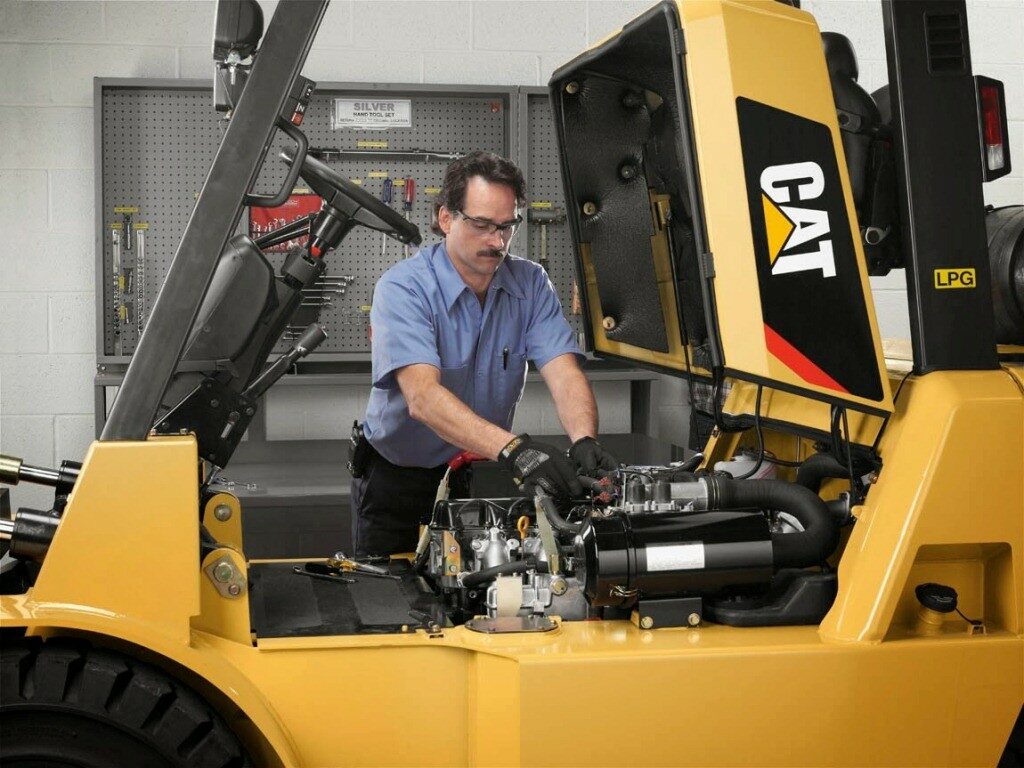
Forklift battery maintenance
The continuous maintenance of the batteries is essential for the forklift to work safely at all times and be ready to carry out its work.
- Industrial batteries, like all pieces of industrial equipment, require proper maintenance to prolong their useful life.
- Battery life always extends when the proper maintenance regimes are observed.
- On the other hand, in bad conditions, industrial batteries used improperly cannot realize their full potential for the duration of the warranty period.
- This is what should and should not be done in battery care for users of motive power batteries.
An efficient way to check if the battery works properly is to make a small voltage discharge. If the verification of all these issues is successful, it means that the battery is in good condition. However, to maximize the maintenance of forklift batteries, these recommendations should be taken into account:
- keep batteries between 15 and 25 degrees centigrade
- keep the batteries fixed
- avoid partial recharges or that the battery is completely discharged
- do not use them too much
That is why the maintenance of forklift batteries is so important to give more life to it.

Forklift battery charger
During the recharging of the batteries, potentially flammable gases such as oxygen and hydrogen can be produced. Choose and carefully maintain the location of the battery recharging station to avoid injury.
- Choose a ventilated room to avoid the accumulation of gases
- Label the area with signs and stripes on the floor that delimit the area of the battery recharging station
- Install eyewash stations and emergency showers near the recharge area in the event of splashes and exposures to acid and other corrosive materials.
- Place a spill kit that includes acid neutralization materials near the location.
- Provide visible instructions in addition to equipment for combat and/or suppression of fires.
Forklift battery repair
Obtain training in inspection, maintenance, and battery recharging procedures. Checkpoints during battery inspection should include:
- Correct levels of fluid
- Verify that the cables are intact, insulated and connected
- The contact terminals must be clean and show no signs of crystallization or corrosion
- Check that there are no cracks in the housing
Other useful general maintenance and safety tips for batteries include:
- Before recharging the batteries, make sure that the forklift is off and with the emergency brake activated
- Make sure the charger is in the OFF position before connecting it or disconnecting it from the battery
- Add the acid slowly to the water, never add water to acid solutions
- Keep the battery vent caps firmly in place so that the emitted gas is vented outside the forklift
- Avoid flames, electric arcs, and sparks near the forklift’s battery
- Never smoke near a battery recharge station
- To avoid electric shocks and burns, remove all metal jewelry and keep metal objects away from the battery, including funnels and containers
Forklift safety
The batteries provide power and counterbalance to the forklifts. Batteries can weigh up to 2,000 pounds so apply best practices and precautions to avoid crush accidents when moving, changing and handling batteries and remember:
- Move the battery only if you have a properly equipped cart and forklift with the necessary capacity
- Securely attach the battery to the transfer equipment and the destination forklift
The recharging of forklift batteries is not a difficult procedure; however, it must be done with great care.
Compliance with workplace safety practices to properly recharge and maintain forklift batteries can prolong the life of the battery and ensure there is always enough charge to complete the work task.
Electric forklift battery
Is it necessary to use electric forklifts and battery recharging operations?
The operation of recharging electric forklift batteries is widely used in the industry but exposes buildings, equipment, stored materials and personnel to losses, including the continuity of operation of the company. Battery recharging operations are particularly common in warehouses where the fuel load is generally high.
The presence of battery recharging operations in proximity with combustible products can generate fire with a high velocity of propagation; therefore, it is advisable to have a robust fire prevention program and control measures that include:
… the relocation outside of buildings of this type of battery recharging operations or the protection with automatic sprinklers both in storage areas and operations with battery recharging.
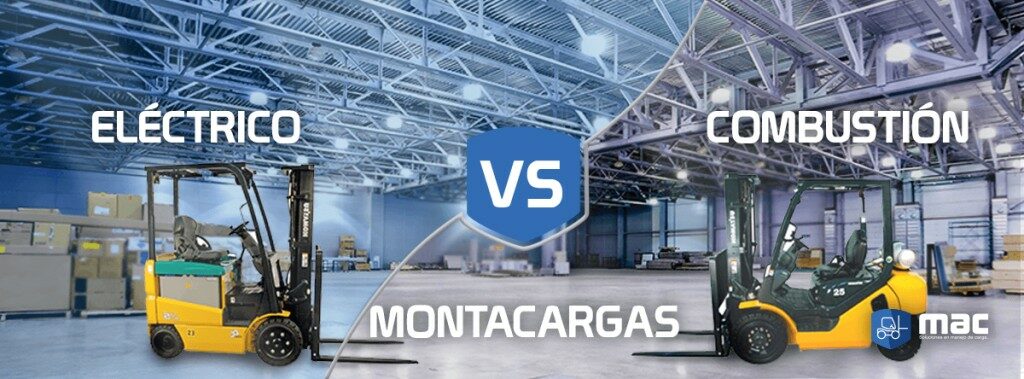
Forklift battery charging station
What is a forklift battery charger?
The industrial charger is responsible for charging the forklift battery as quickly as possible without shortening the battery’s lifespan due to overheating and overcharging. Before the advent of the current generation of forklift battery chargers, the operator was responsible for setting the desired voltage and amperage for charging the battery, thus opening the door for human error and damage.
Today’s industrial charger contains a complex network of cards and sensors that effectively remove the human from the equation. Today, chargers have preset parameters that protect the battery from overcharging and damage.
These preset parameters will actually stop charging and display error codes if there is a problem with the battery instead of pumping the battery full of power until it either boils over or in a worst-case scenario, catches fire.
There are myriad choices as for industrial chargers from small portable chargers that plug into any wall socket, to large wall mounted units that require large amperage capacities with dedicated wiring.
Current chargers allow the user to custom-tune a specific charge cycle. This customization allows you to control everything from the amount of voltage, amperage, charging time, and even the fill rate over a given time span. These controls allow you greater flexibility in charging, as well as longer battery life and performance.
Used forklift batteries
Used forklift batteries are a fraction of the cost of new, and will keep your forklift running.
Used forklift batteries are extremely heavy-duty and can be recharged a number of times. By following these basic tips, you will extend the useful life of your forklift battery significantly, saving you money and reducing forklift downtime.
- Replacing the water in the battery will help keep the interior from corroding, and distilled or deionized water is preferred.
- The fluid level should typically be about ¼’’ below the vent wall neck after the battery is charged, and fluid should not be added before charging the used battery.
- When using a forklift battery, do not discharge more than 80%.
- An average life cycle that helps ensure a longer-lasting forklift battery is around a 50% discharge.
- The reconditioned, used battery should also be equalized every 5 to ten charge cycles, and this is basically a controlled overcharging that adjusts the voltage difference between the cells.
- It also helps get rid of the sulfate particles that build upon the plates.
If your used forklift’s battery ever overspills, make sure to wash it immediately with water and baking soda to stop corrosion from forming on top of or underneath the battery.
If this isn’t done quickly the battery can be completely ruined. It is a good idea to wash the outside of the battery twice a year because acid vapors escape during recharge. These vapors cause residue to build up around the vent cap area, which will eventually corrode and damage the outside of the battery.
How long do forklift batteries last?
5 years. Most new batteries start with 1500 cycles prior to the end of its usable battery life. A battery charged once each working day (300 per year) will last 5 years (1500 cycles). Opportunity charging (mentioned below) can reduce the life by over half. “Remember, the battery is the fuel tank of the forklift.
Used forklift batteries usually cost around $1,500 to $3,500. You can buy used industrial batteries through a local material handling or battery dealer.
Lead-acid forklift batteries have two main functions. They provide a power source and act as a counterweight to a lift truck. A typical lead-acid battery is made up of a battery case, battery cells, and battery cables that come together to house a liquid electrolyte mixture of sulfuric acid and water.
You should add water to the forklift battery after its charge. Typically, batteries need watering 1x / weekly.
The weight of these heavy batteries can crush hands and feet if care is not taken when charging and handling them. Adequate and proper handling of equipment should be provided. The average lift truck battery weighs over 2000 pounds.
The most read
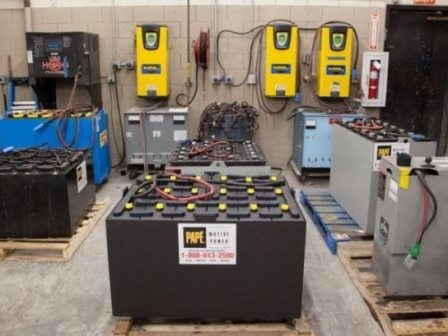
Reconditioned Forklift Battery
Sulfation is crystallization that forms a hard shell surrounding the lead plates within the battery cell, this shell prevents efficient charging and discharging of the battery.
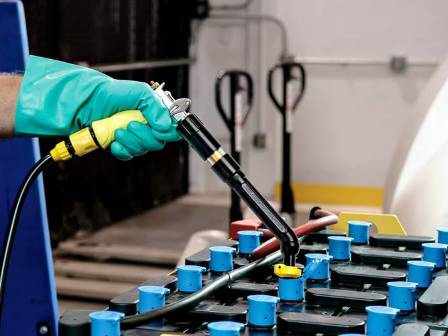
Forklift Battery Charger
Your forklift truck will run on its own battery if it’s an electric vehicle. The battery is a vital piece of equipment and must be cared for and kept charged in order for your truck to work properly.
